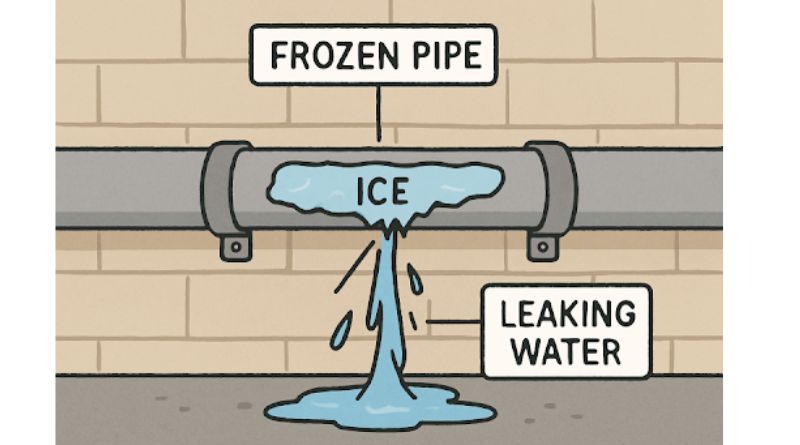What Causes Pipes to Burst — And How to Prevent It
Burst pipes are one of the most stressful plumbing emergencies homeowners can face. They can cause significant water damage, disrupt daily routines, and lead to costly repairs if not addressed quickly. Common causes include freezing temperatures, aging pipes, high water pressure, and corrosion—all of which weaken the pipe’s structure over time. Understanding these factors is the first step toward prevention, as proper maintenance and insulation can help protect your plumbing system from unexpected failures.
When a pipe bursts, immediate professional intervention is essential to minimize damage and restore functionality. Experienced burst pipe repair specialists in Utah can quickly identify the source of the problem, stop leaks, and perform lasting repairs using high-quality materials and proven techniques. These experts also offer preventive solutions, such as pressure regulation and system inspections, to reduce future risks. Relying on skilled professionals ensures your plumbing system remains durable, safe, and ready to handle changing conditions.
Freezing Temperatures
Winter brings the most significant risk of pipe bursts, particularly in regions where sub-zero temperatures are the norm. When the temperature dips, water inside exposed pipes can freeze. Frozen water expands, producing extreme pressure that can fracture even durable materials. This risk is most severe in pipes running along exterior walls, in attics, or in basements. Simple solutions, such as using foam-based pipe insulation or keeping cabinets open to allow warm air to circulate near vulnerable pipes, are often enough to keep pipes from freezing.
High Water Pressure
While high water pressure offers satisfying showers, it quietly taxes your plumbing network. Most residential systems function best between 40 and 60 psi (pounds per square inch). When water pressure exceeds this range, the increased force can compromise pipe joints and seals—eventually causing leaks that escalate into bursts. A pressure gauge, available at most hardware stores, can help you monitor your system. For significant variance, installing a pressure-reducing valve is a wise long-term investment. These practical devices can extend the lifespan of your plumbing and avoid emergencies.
Corrosion and Aging Pipes
As with all building materials, pipes deteriorate with age. Metal pipes—such as galvanized steel, copper, or iron—are especially vulnerable to gradual corrosion from chemical reactions with minerals or even oxygen in the water. Pipe walls weaken over decades, becoming increasingly brittle and prone to rupture. Visible signs of corrosion include discoloration, flaking, and a metallic taste in the water. Homeowners in older properties—particularly those more than 50 years old—should schedule professional inspections and replace plumbing as needed with modern materials, such as PEX or CPVC.
Clogs and Blockages
Over time, everyday debris—including hair, grease, soap scum, and mineral deposits—can accumulate inside your pipes. These blockages not only slow drainage but also create points of increased water pressure. If ignored, the pressure buildup behind a stubborn clog can force the pipe to split or burst. Preventative measures include educating everyone in your household not to flush inappropriate items, regularly cleaning drains, and using enzymatic—not chemical—cleaners to maintain free-flowing pipes.
Tree Root Intrusion
Outside, mature trees and large shrubs present a threat that many homeowners overlook. Root systems, in their search for water, naturally gravitate toward pipe seams and may infiltrate even tiny cracks. Once inside, roots expand and worsen damage, resulting in leaks or significant backups. Early warning signs include slow drains, unexplained wet spots in your yard, or recurring sewer backups. Preventive landscaping—such as selecting plant species with non-invasive roots and installing root barriers—can help protect your underground systems.
Improper Installation
Even the newest, most reliable pipes can fail if not installed according to code. Common errors involve loose fittings, insufficient support, or the use of low-quality materials. These mistakes often go unnoticed until a failure occurs, leading to unexpected water damage. Always hire licensed professionals for plumbing repairs or renovations, and verify they adhere to current building standards. Regular home inspections are a simple way to catch potential installation issues before they escalate.
Preventive Measures
Reducing your risk of dealing with burst pipes starts with simple, proactive habits. Here are practical steps to protect your plumbing:
- Insulate Pipes: High-quality foam or fiberglass works well for both hot and cold water lines.
- Monitor Water Pressure: Check with a gauge at least once a year; adjust as needed.
- Schedule Regular Inspections: An annual visit from a professional plumber can spot risks early and save you money in the long run.
- Clean Drains Properly: Avoid using chemical drain cleaners that can corrode your pipes; enzymatic or manual cleaning methods are safer alternatives.
- Be Cautious with Landscaping:Research trees and shrubs before planting, and always consider the placement of underground lines.
Home emergency preparedness, including knowing where your main shut-off valve is and having a trusted plumber’s number on hand, can make all the difference in protecting your investment.
Conclusion
Burst pipes pose a significant threat to any property, often resulting in major water damage and stress. The good news is that most causes are preventable, given a bit of regular attention and preparation. Prioritizing maintenance and modern plumbing updates today can save significant time, money, and hassle in the future. Always err on the side of caution—and remember that expert help is just a call away when needed.
Read Also:




